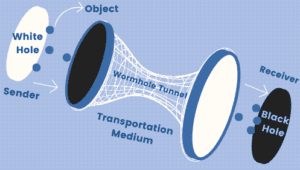Learn through the super-clean Baeldung Pro experience:
>> Membership and Baeldung Pro.
No ads, dark-mode and 6 months free of IntelliJ Idea Ultimate to start with.
Last updated: March 18, 2024
There are various optimization algorithms in computer science, and the Multi-Verse Optimization Algorithm (MVO) is one of them.
In this tutorial, we’ll take a look at what this algorithm means and what it does.
Then, we’ll go through the steps of the MVO algorithm. Finally, we’ll use a numerical example to demonstrate the solution to an optimization issue using MVO.
MVO is a population-based algorithm and a meta-heuristics algorithm based on the concepts of the multi-verse theory. As implied by the name, Seyedali Mirjalili introduced this approach for solving numerical optimization issues in 2015. The MVO algorithm is a physics-inspired technique, in particular, it’s inspired by the three main concepts of the multi-verse theory: white holes, black holes, and wormholes.
The term multi-verse stands opposite to the universe and challenges the notion of uniqueness, which refers to the existence of additional worlds in addition to the one in which we all live. So, there might be duplicates, not only of objects but also of me, you, and everyone else.
In the multi-verse theory, multiple universes interact and may even collide with one another. The multi-verse approach also indicates that each world may have its own set of physical rules. The three fundamental concepts of the multi-verse theory are white holes, black holes, and wormholes.
Although a white hole has never been observed in our world, the big bang may be regarded as a white hole and maybe the primary component in the formation of a universe. In addition, it is known in the cyclic model of the multi-verse theory that white holes (big bangs) are generated where parallel universes collide. Here’s an example of white holes:

Black holes, which have been discovered on several occasions, act radically differently from white wholes. With their tremendously strong gravitational pull, they attract everything, including light beams. The image below represents an example of black holes:

Wormholes are holes that link various sections of the universe. They operate as time/space travel tunnels in the multiverse approach. Items may move instantly between any two corners of a universe or even from one universe to another via these tunnels. Here’s an example of wormholes:

Let’s take a look at the principles that we apply, during the optimization process, to the universe of MVO:
Let’s divide the search procedure, which is used by a population-based algorithm, into two parts: exploration and exploitation. In order to explore search spaces through MVO, we use the ideas of a white hole and a black hole. Wormholes, on the other hand, help MVO exploit the search spaces.
Each solution is equivalent to a universe, and each variable in that world is an object. Furthermore, we apply an inflation rate to each solution that is proportional to the solution’s associated fitness function value.
We employ a roulette wheel mechanism to describe the mathematical model of the white and black hole tunnels, as well as the movement of objects across universes. The roulette wheel table, which is a game of chance, contains numbers
. The color of number
is green and the others colored with
red &
black. The graph below presents the roulette wheel:

So, we use the roulette mechanism to choose one universe among all for the white holes. At each iteration, we´ll sort the universe according to their fitness value (inflation rate) and select one using roulette.
According to multi-verse theory, we have more than one universe:
The model below shows the mathematical model that we can use for the selection of one universe using the roulette wheel selection mechanism:
Where represents the
parameter of the
universe selected by the roulette wheel mechanism,
refers to the
parameter of the
universe,
is the
universe, and
is a random value in the interval
.
Using this mechanism universes can exchange objects with each other without any disorganization.
As we said before, the wormholes act as tunnels in between the black hole and white hole. So, let’s assume that each universe has wormholes to assure the exchange randomly of objects through space. The wormholes randomly change objects without consideration of their inflation rates. Let’s now suppose that wormhole tunnels are always established between a universe and the best universe (to provide local changes to each universe). Let’s discover the formulation of this mechanism:
Where represents the
variable of the fittest universe created,
refers to the
parameter of the
universe,
,
, {
,
,
}
random numbers in the interval
,
, and
.
The equations below represent the and the
:
Let’s now take a look at the implementation of the MVO optimizer and its tile complexity.
The algorithm below represents the multi-verse optimizer:
algorithm MultiVerseOptimizer(U):
// INPUT
// U = initial random universes
// OUTPUT
// the Best Universe
Initialize WER, TDR, and Best Universe
SU <- Sorted universes
NI <- Normalize inflation rate (fitness) of the universes
while the end criterion is not satisfied:
Evaluate the fitness of all universes
for each universe (indexed by i):
Update WEP and TDR
Black hole index <- i
for each object (indexed by j):
r1 <- random([0, 1])
if r1 < NI(U[i]):
White hole index <- RouletteWheelSelection(-NI)
U[Black hole index, j] <- SU[White hole index, j]
r2 <- random([0, 1])
if r2 < WEP:
r3 <- random([0, 1])
r4 <- random([0, 1])
if r3 < 0.5:
U[i, j] <- Best Universe[j] + TDR * ((ub[j] - lb[j]) * r4
+ lb[j])
else:
U[i, j] <- Best Universe[j] - TDR * ((ub[j] - lb[j]) * r4
+ lb[j])
return Best UniverseAs we can see in the algorithm, the population size (number of universes) and the maximum number of iterations are needed as inputs in order to get the Best Universe and its Fitness value as the output of the algorithm.
We start by initializing the parameters {}, {
} and the population size
}. Then, we evaluate each solution by calculating its value using the fitness function. After evaluating each solution in the population, we assign the best solution according to its value. Afterward, we update the parameters
.
In order to select one universe among N, we use the roulette wheel selection mechanisms as a white hole. Then, we use a wormhole as a tunnel for object exchange between different universes. We repeat the overall operations until the stopping criteria are matched, which means we will check the current iteration until we reach the maximum number of iterations to return the best global solution.
It is worth noting that the time complexity of the multi-verse algorithm is generally related to the number of iterations (), the number of universes (
), and the number of objects (
). So, the equation below represents the time complexity of this algorithm:
In more detail, we employ the QuickSort algorithm in every iteration, which has the complexity of in the worst case. In addition, we use the roulette wheel mechanism for every variable in every universe over the iterations, which has the complexity of
in the worst case. Let’s reconstruct the time complexity of the multi-verse algorithm using the complexity of Quick Sort and roulette wheel mechanism:
To understand the multi-verse optimizer algorithm, we use a numerical example.
Firstly, we randomly initialize the population size (total number of universes) . Afterward, we initialize all the parameters using a random set of values:
Here’s the initial position for the four universes ():
| Sr. No | 1 | 2 | 3 | 4 | 5 |
|---|---|---|---|---|---|
| 1. | -70.8536 | 85.1716 | -43.5590 | -26.9935 | -33.5764 |
| 2. | 17.0087 | -1.4723 | 95.1915 | -38.1701 | 79.4960 |
| 3. | -85.3277 | 30.9766 | -92.7149 | -75.8175 | -0.0702 |
| 4. | 64.4652 | 78.0247 | -34.7511 | 83.1531 | 23.0576 |
| Sr. No | 6 | 7 | 8 | 9 | 10 |
|---|---|---|---|---|---|
| 1. | 39.6508 | -32.0028 | -90.4425 | -77.1940 | -72.7985 |
| 2. | -94.1335 | 69.3422 | -89.2045 | 59.2491 | 57.7783 |
| 3. | 5.5765 | -50.7861 | -95.8764 | 23.5701 | -81.5203 |
| 4. | -93.5854 | 16.2983 | 36.2957 | -85.9573 | -52.4262 |
Here’s the fitness function in order to compute the fitness value for each universe and select the Best Universe:
Let’s calculate the fitness value for each universe in the current population using the fitness function:
| Sr. No | Fitness Value |
|---|---|
| 1. | 3.8063 * e⁴ |
| 2. | 4.5605 * e⁴ |
| 3. | 4.1588 * e⁴ |
| 4. | 3.9376 * e⁴ |
After calculating all the fitness values (inflation rate of each universe), we select the optimal solution (Best Universe) among all. The optimal solution is the one that has the smallest fitness value across all universes. As a result, is the best solution for the first iteration. Let’s move forward to update the parameters of
and
for each universe:
We need to select one universe among N by using the roulette wheel selection mechanism as a white hole based on the mathematical model below:
Where is chosen at random from the interval
. So, to elect one among all for the white hole, we apply the two rules below:
In other words, the fitness value with the highest value represents the only white hole. At each iteration, we’ll sort the universe according to the fitness value. The table below depicts the choosing of one white hole as the second universe, while the other universes are black holes:
| Sr. No | Fitness Value |
|---|---|
| 1. | 3.8063 * e⁴ |
| 2. | 4.5605 * e⁴ |
| 3. | 4.1588 * e⁴ |
| 4. | 3.9376 * e⁴ |
Let’s now use a transportation medium to move objects from the universe with a white hole to the universe with a black hole. In this case, we use the wormhole as the tunnel to exchange objects between different universes:

So, the wormholes act as time/space travel tunnels between different universes based on the mathematical model below:
Where are chosen at random from the interval
. We have
then
. This means the best universe formed with the
.
Let’s now check the maximum iteration and the current iteration then we repeat the steps above until reaching the criteria. After the repetition of the loop, we got the best optimum value . Then, we display
as the best universe.
In this article, we discussed the multi-verse optimization algorithm using a numerical example to unlock its mechanism. This algorithm searches for the best universe, which represents the best solution to a problem based on the multi-verse theory. We introduced this algorithm because it’s highly effective in solving global unconstrained and constrained optimization issues.